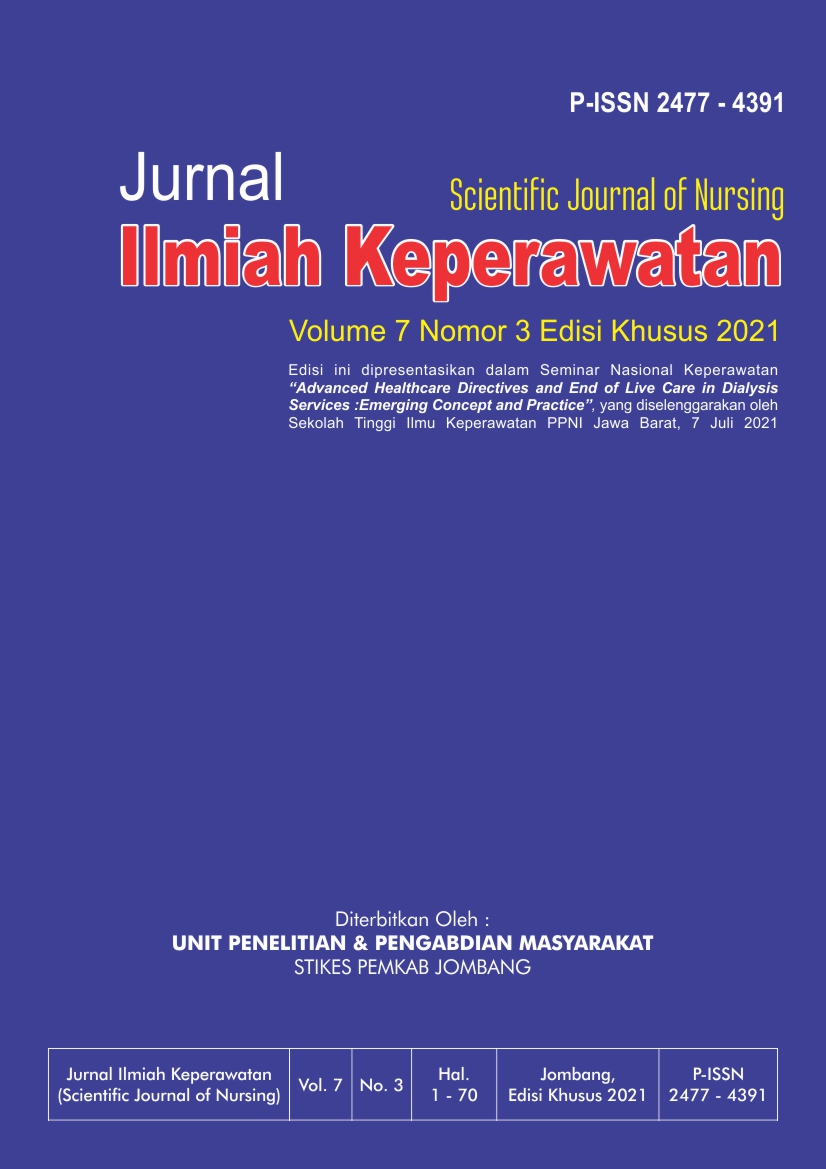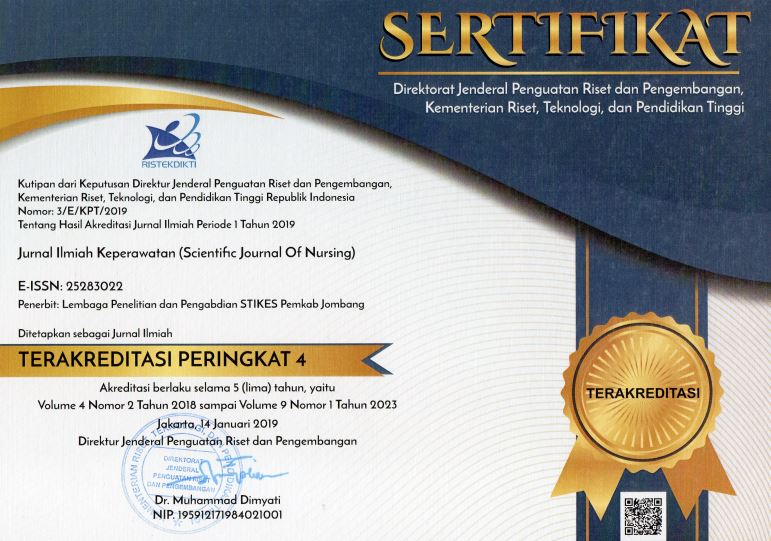Hubungan Fatigue Terhadap Kualitas Hidup Pasien Hemodialisa
DOI:
https://doi.org/10.33023/jikep.v7i3.813Keywords:
fatigue, kualitas hidup, hemodialisAbstract
Latar Belakang : Hemodialisa membantu meningkatkan harapan hidup pasien penyakit ginjal kronis, namun pasien juga sering melaporkan masalah dari pengobatan tersebut salah satunya fatigue yang merupakan gejala paling umum dari pasien hemodialisa dan sering dikaitkan dengan masalah kualitas hidup . Tujuan : Mengetahui hubungan fatigue terhadap kualitas hidup pasien hemodialisis. Metode : Desain penelitian yang digunakan adalah studi korelasional dengan pendekatan cross-sectional. Populasi penelitian ini adalah pasien yang menjalani hemodialisis di berbagai Klinik Hemodialisis di Kota Bandung dengan tehnik pengambilan sampel menggunakan consecutive sampling . Instrumen yang digunakan dalam penelitian ini yaitu the Fatigue Severity Scale (FSS) dan Kidney Disease Quality of Life Short Form 36 (KDQoL-SF36). Analisis univariat menggunakan distribusi frekuensi. Analisis bivariat dilakukan dengan menggunakan uji korelasi pearson. Hasil : Dari 34 responden sebagian besar pasien mengalami fatigue dengan rerata tingkat fatigue 41.18 (SD=17.11). Sekitar 41% responden memiliki skor fatigue tinggi (45<FAS<=63). Rerata skor KDQoL-SF36 pada aspek daftar gejala/masalah 66.02 (SD=9.06), aspek efek penyakit ginjal 43.70 (SD=10.68), aspek beban penyakit ginjal 12.13 (SD=5.94), aspek komponen kesehatan fisik 35.7 9 (SD=6.58) dan aspek komponen kesehatan mental 45.51 (SD=7.82). Terdapat hubungan antara fatigue dengan aspek beban penyakit ginjal dan komponen kesehatan fisik terlihat dari nilai p value <0.05 dengan nilai koefisien korelasi sebesar (-0.491) dan (-0.515). Kesimpulan: Semakin tinggi skor fatigue maka semakin rendah skor aspek kualitas hidupnya
Downloads
References
Artom, M., et al, 2014, ‘Fatigue in advanced kidney disease’. Kidney International, 86(3),1–9.
Bai, Y., Chang, Y., Chiou, C & Lee, B, 2018, ‘Mediating effects of fatigue on the relationships among sociodemographic characteristics, depression, and quality of life in patients receiving hemodialysis’, Nurs Health Sci. 2018;1–8.
Borg, Ms & Verdonk, Petra & Jong-Camerik, Ms & Abma, Tineke, 2021, How to relate to dialysis patients' fatigue - perspectives of dialysis nurses and renal health professionals: A qualitative study. International Journal of Nursing Studies. 117. 103884.
Butarbutar, D., Sudira, P., Astuti, & Setyaningsih, I., 2014, Uji Reliabilitas dan Validitas Kuesioner Fatigue Severity Scale Versi Bahasa Indonesia Pada Dokter Residen Rumah Sakit Umum Pusat Dr. Sardjito, Pertemuan Ilmiah Regional XXVI.
Dokter Spesialis Saraf JOGLOSEMARMAS
Cervantes, et al, 2021, ‘Patient-reported outcomes and experiences in the transition of undocumented patients from emergency to scheduled hemodialysis’, Kidney International , 99(1):198-207.
Cohen, D., et al., 2019, Use of the KDQOL-36™ for assessment of health-related quality of life among dialysis patients in the United States, BMC Nephrology (2019) 20:112.
E?lence, R., Karata?, N., & Ta?ci, S., 2013, ‘The effect of acupressure on the level of fatigue in hemodialysis patients’, Altern Ther Health Med. Nov-Dec;19(6):23-31.
Georgios, T., et al, 2015, ‘Assessment of Quality of Life and Fatigue among Haemodialysis Patients’, American Journal of Nursing Science, Special Issue: Mental Health Care: Aspects, Challenges and Perspectives, Vol. 4, No. 2-1, 2015, pp. 66-73.
Indonesian Renal Resgistry, 2018, 11th Report Of Indonesian Renal Registry. https://www.indonesianrenalregistry.org/data/IRR%202018.pdf diakses pada tanggal 26 Oktober 2020
I??k Ulusoy, S., & Kal, Ö, 2020, ‘Relationship Among Coping Strategies, Quality of Life, and Anxiety and Depressive Disorders in Hemodialysis Patients. Therapeutic apheresis and dialysis : official peer-reviewed journal of the International Society for Apheresis’, the Japanese Society for Dialysis Therapy, 24(2), 189–196.
Jacobson, et al, 2019, ‘Patient Perspectives on the Meaning and Impact of Fatigue in Hemodialysis: A Systematic Review and Thematic Analysis of Qualitative Studies’, American Journal of Kidney Disease, Vol 74, Issue 2, P179-192.
Jhamb, M., Pike, F., Ramer, S., Argyropoulos, C., Steel, J., Dew, M. A., …Unruh, M, 2011, ‘Impact of fatigue on outcomes in the hemodialysis (HEMO) study’, American Journal of Nephrology, 33(6), 515–523.
Natashia, D., Irawati, D., & Hidayat, F., 2020, Fatigue Dan Kualitas Hidup Pada Pasien Gagal Ginjal Kronis Dengan Terapi Hemodialisa, Jurnal Keperawatan Muhammadiyah 5 (2) 2020.
Smart N, & Steele M, 2011, ‘Exercise training in haemodialysis patients: a systematic review and meta-analysis’, Nephrology (Carlton), 2011 Sep;16(7):626-32.
Supriyadi, R., Rakhima, F., Gondodiputro, R., & Darmawan, G., 2019, ‘Validity and Reliability of the Indonesian Version of Kidney Disease Quality of Life (KDQOL-36) Questionnaire in Hemodialysis Patients at Hasan Sadikin Hospital, Bandung, Indonesia’, Indones J Intern Med, Vol 51, Number 4.
Toruan, E., 2019, Pengaruh Lotion Oat Terhadap Sensasi Gatal Pada Pasien Hemodialisa yang Mengalami Pruritus di RS Kota Medan, Tesis Program Studi Ilmu Keperawatan Fakultas Keperawatan Universitas Sumatera Utara.
Yang, P. C., & Lu, Y. Y, 2017, ‘Predictors of fatigue among female patients on hemodialysis’, Nephrology Nursing Journal, 44(6), 533–539.
Yu, H. D., & Petrini, M. A, 2010, ‘The HRQoL of Chinese patients undergoing haemodialysis’, Journal of Clinical Nursing, 19(5–6), 658–665.
Published
How to Cite
Issue
Section
Authors who publish with Jurnal Ilmiah Keperawatan (Scientific Journal of Nursing) agree to the following terms:
- Authors retain copyright and grant Jurnal Ilmiah Keperawatan (Scientific Journal of Nursing) the right of first publication with the work simultaneously licensed under a Creative Commons Attribution 4.0 International License that allows others to remix, adapt and build upon the work with an acknowledgment of the work's authorship and of the initial publication in Jurnal Ilmiah Keperawatan (Scientific Journal of Nursing).
- Authors are permitted to copy and redistribute the journal's published version of the work (e.g., post it to an institutional repository or publish it in a book), with an acknowledgment of its initial publication in Jurnal Ilmiah Keperawatan (Scientific Journal of Nursing).









